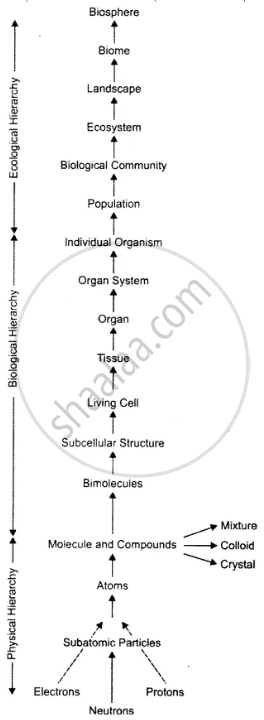Advertisements
Advertisements
प्रश्न
With reference to the levels of an organisation, differentiate between living organisms and non-living objects.
उत्तर
The organisation is a systematic arrangement of smaller and simpler components into a larger one in a hierarchy or pyramid of levels where each level is formed of components of a lower level and itself becomes part of a higher-level for achieving a common goal.
Three levels of organisation are met in nature – physical biological and ecological. At every level two types of questions arise – how (mechanism of the process) and why (significance of the process).

Various levels of organisation.
The non-living objects occur as molecules and compounds which are found as mixture, colloids, and crystals. They are formed of atoms, atoms are formed of subatomic particles, which are ^ composed of electrons, protons, and neutrons the lowest structures.
In the living organisation, the molecules and g compounds polymerise and aggregate to form o’ biomolecules. The different biomolecules aggregate and organise to form different subcellular structures (= organelles) which together constitute the first living component of the cell (individual unicellular organism). The cells may be held together to form tissue and different tissues together form organs.
The different organs constitute an organ system § and different organ systems form a multicellular ± complex whole Called individual organism the basic unit of ecology. if An aggregation of individuals of the same species is m called population. The assemblage of a population of different species present in an area is called Biological Community.
The different biological communities and the physical environment both get integrated to form a self-sufficient, self-regulated fragment of nature, called the ecosystem.
The different ecosystems characterised by specific climatic zone, form a major category of regional gecological organisation called Biome. Biomes are of two types-terrestrial and aquatic.
APPEARS IN
संबंधित प्रश्न
“It is often said that the pyramid of energy is always upright. On the other hand, the pyramid of biomass can be both upright and inverted.” Explain with the help if examples and sketches.
Secondary consumers are __________.
Which ecosystem has the maximum biomass?
Which of the following organism form the decomposers?
Which of the following statements is not correct?
Name any two organisms which can occupy more than one trophic level in an ecosystem.
Organisms at a higher trophic level have less energy available. Comment.
Draw a diagram of pyramid of energy.
Give scientific reasons:
The pyramid of energy is always upright.
| In a forest ecosystem, a large population of insect feeds upon a banyan tree. Several small birds feed upon these insects. The small birds are fed upon by big-sized birds. |
- With respect to this ecosystem, draw a pyramid for each biomass and a pyramid of number.
-
If 20,000 Kcal energy is available at the level of insects, calculate the amount of energy available at the level of big-sized birds.
